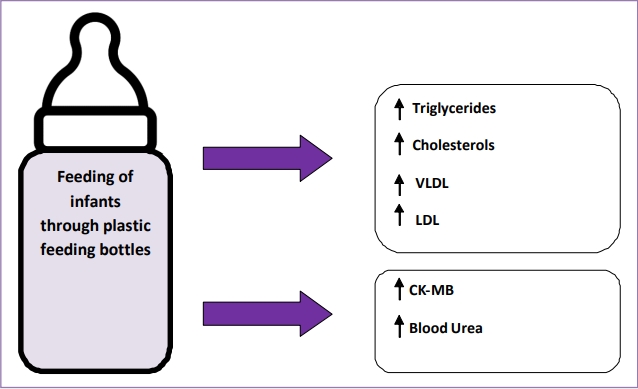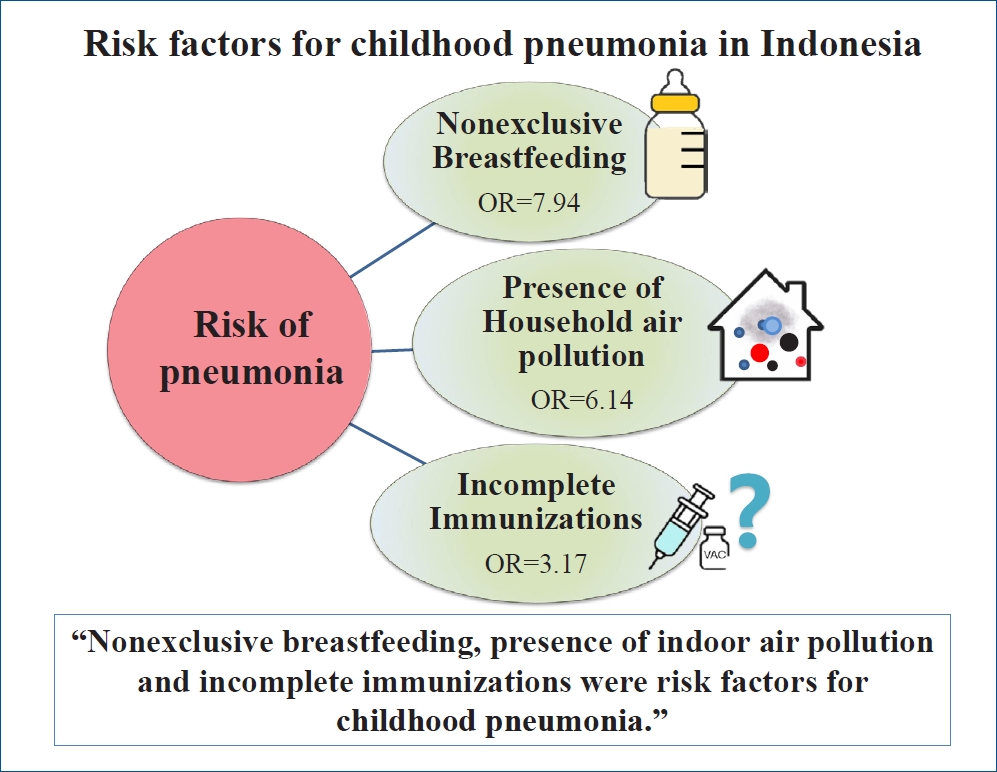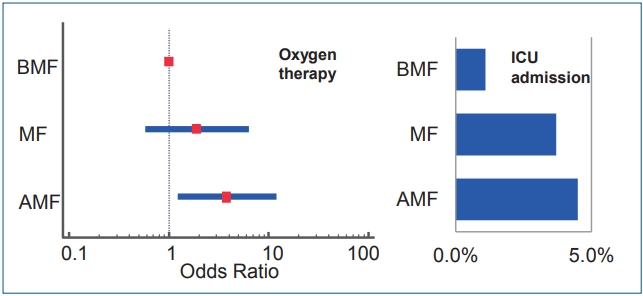Search
- Page Path
-
- HOME
- Search
- Original Article
- Other
- Plastic bottle feeding produces changes in biochemical parameters in human infants – A pilot study
- Mahendra K. Pant, Abul. H. Ahmad, Manisha Naithani, Jayanti Pant
- Clin Exp Pediatr. 2022;65(9):459-465. Published online May 19, 2022
-

Question: Plastic feeding bottles are used commonly to feed infants who cannot be breastfeed. Does plastic bottle feeding produce biochemical changes in infants?
Finding: The plastic bottles leach out endocrine disruptors and affects bodily functions in terms of biochemical alterations like increased blood urea, raised creatine-kinase–MB levels, and altered lipid profile in infants exposed to bottle feeding.
Meaning: Plastic bottles feeding alters bodily functions in infants.
- General Pediatrics
- Risk factors for childhood pneumonia: a case-control study in a high prevalence area in Indonesia
- Vivi Ninda Sutriana, Mei Neni Sitaresmi, Abdul Wahab
- Clin Exp Pediatr. 2021;64(11):588-595. Published online March 15, 2021
-

Question: Is the incidence of childhood pneumonia influenced by breastfeeding and basic immunization status?
Finding: Exclusive breastfeeding and complete basic immunization status have an effect in limiting the incidence of childhood pneumonia.
Meaning: While exclusive breastfeeding and complete basic immunization the Expanded Program on Immunization status are important factors for reducing the incidence of childhood pneumonia, indoor air pollution was also a significant risk factor.
- Nutrition
- Positive association of breastfeeding on respiratory syncytial virus infection in hospitalized infants: a multicenter retrospective study
- Min Jeong Jang, Yong Joo Kim, Shinhye Hong, Jaeyoon Na, Jong Hee Hwang, Son Moon Shin, Young Min Ahn
- Clin Exp Pediatr. 2020;63(4):135-140. Published online November 12, 2019
-

Question: Human milk has stronger antiviral, antibacterial, and anti-inflammatory properties compared with formula milk. How dose breastfeeding affect respiratory syncytial virus infection in Korea?
Finding: Breastfed infants required less oxygen therapy and possible intensive care unit admission than artificial formulafed infants during respiratory syncytial virus infection.
Meaning: This protective role of breast milk on RSV severity can be a supporting evidence for promoting breastfeeding in Korea.
- Iron and vitamin D status in breastfed infants and their mothers
- Yu Sun Kang, Joon Hwan Kim, Eun Hee Ahn, Eun-Gyong Yoo, Moon Kyu Kim
- Clin Exp Pediatr. 2015;58(8):283-287. Published online August 21, 2015
-
Purpose We assessed the relationships between iron and vitamin D statuses in breastfed infants and their mothers and evaluated the determinants of iron and vitamin D deficiencies in breastfed infants.
Methods Seventy breastfed infants aged 4-24 months and their mothers participated in this study from February 2012 to May 2013. Complete blood counts, total iron binding capacity, and levels of C-reactive protein, iron,...
- Complete rooming-in care of newborn infants
- Yoo Min Lee, Kang Hoon Song, Young Mi Kim, Jin Sun Kang, Ji Young Chang, Hyun Joo Seol, Yong Sung Choi, Chong Woo Bae
- Clin Exp Pediatr. 2010;53(5):634-638. Published online May 31, 2010
-
Purpose In Kyung Hee East-West Neo Medical Center, Seoul, Korea, efforts to raise rooming-in care success rate have been undertaken since when the hospital was established in 2006. We intended to analyze our experience over the past 3 years of period and to discuss the advantages of rooming-in.
Methods We analyzed the rooming-in practice rate, failure rate, and the breast feeding rate. Subjects...
- Predisposing factors to nipple confusion
- Ji Hyun Kim, Og Ryeon Cha, Yu Kyung Seo, Sun Ju Lee, Sung Min Cho, Byung Chan Park
- Clin Exp Pediatr. 2008;51(4):362-366. Published online April 15, 2008
-
Purpose : The purpose of this study is to investigate the predisposing factors for nipple confusion by using questionnaires. Methods : From October, 2005 to October, 2006, we performed a survey on guardians of neonates who had been admitted to the nursery at Dongguk University Medical Center and were discharged 10 to 14 days before the survey. We reviewed their medical... -
- Usefulness of auditory brainstem response as early predictor of kernicterus in early breast-feeding jaundice
- Jae Won Jang, Gil Sang Lee, Dae Keun Song, Sung Hee Kim, Won Duck Kim, Sang Geel Lee
- Clin Exp Pediatr. 2007;50(9):848-854. Published online September 15, 2007
-
Purpose : The present study examined the etiology and risk factors of the early breast-feeding jaundice and the usefulness of auditory brainstem response test as early predictor of kernicterus. Methods : Medical records of neonatal jaundice in newborn admitted to Daegu Fatima Hospital between September 2005 and May 2006 were analyzed prospectively. Infants were grouped according to feeding method : breast... -
- A Study on the Relationship between School-age Obesity and Type of Feeding in Infant Period
- Kyung Lae Cho, Soo Young Kim
- Clin Exp Pediatr. 2005;48(11):1166-1171. Published online November 15, 2005
-
Purpose : The aim of this study was to evaluate whether breast milk feeding at infancy has the effect of a programming agent preventing school-age obesity, or whether formula milk feeding is the cause of elementary school-age obesity. Methods : We randomly selected 4 elementary school in Masan and Changwon city. We calculated the BMI and obesity degree from height... -
- Current Understanding and Practices of Breast feeding by Mothers
- Eun Young Park, Su Jin Cho, Keun Lee
- Clin Exp Pediatr. 2005;48(11):1162-1165. Published online November 15, 2005
-
Purpose : The objective of this survey was to develop an operational plan for breast feeding education. In order to comprehend current breast feeding patterns, we aimed to examine the knowledge, attitude and practices regarding breast feeding of mothers and to compare the data with a similar study done 6 years ago. Methods : A total of 127 mothers who delivered... -
- Growth Patterns of Breast Fed and Formula Fed Infants
- Ju Young Kwak, Jun Young Park, He Jin Lee, Hi Jin Jung, Sang Hi Son, Soo Jin Jung
- Clin Exp Pediatr. 2005;48(10):1055-1060. Published online October 15, 2005
-
Purpose : The purpose of this study is to compare the growth pattern of breast fed and formula fed infants in the first 1 year of life. Methods : Anthropometric data(weight, length, head circumference) of at birth, 1, 3, 6, 9 and 12 months were collected by chart review and characteristics of subjects were collected by questionnaires. Among 358 infants,... -
- The Difference between Clinical Manifestations and Feeding or Delivery Methods in Healthy Full-term Neonates and Those with Nosocomial Rotaviral Infection
- So Young Lee, Hyun Ji Kim, Mi Young Kim, Won Duck Kim, Dong Seok Lee, Doo Kwun Kim, Sung Min Choi
- Clin Exp Pediatr. 2003;46(5):454-458. Published online May 15, 2003
-
Purpose : Rotavirus is the main cause of infantile diarrheal disease worldwide. The purpose of this study is to assess the difference between clinical manifestations and feeding or delivery methods in healthy full-term neonates and those with nosocomially-acquired rotaviral infection. Methods : The study was conducted on 348 babies who were delivered in Dongguk University Kyongju Hospital from Jan 1... -
- A Survey on the Factors of Breast Feeding Failure Related to the Role of Medical Personnels
- Min Jung Cho, Cheong Mi Cheon, Jeong Kyung Seo, Son Moon Shin
- Clin Exp Pediatr. 2001;44(4):389-396. Published online April 15, 2001
-
Purpose : The reasons for breast feeding failure within the first month of birth were related to inappropriate handling of problems in breast feeding. We investigated common reasons for the failure during the neonatal period and assessed medical personnels` attempts to solve them. Methods : We conducted a survey with a prepared questionnaire on one-hundred-twenty mothers who failed in breast feeding... -
- A Survey of Breast-Feeding
- Yun Ah Sung,, Ju Yong Ahn, Hwa Yeon Lee, Jae Yoon Kim, Don Hee Ahn, Yong Jin Hong
- Clin Exp Pediatr. 1998;41(4):444-450. Published online April 15, 1998
-
Purpose : The superiority of breast-feeding to artificial feeding of infants aged 6 months or less has been well established. Due to the low rate of breast-feeding in our 1994 hospital survey we recommended and educated about breast-feeding to mothers who delivered in our hospital since January 1995. The purpose of this survey is to assess if the rate of breast-feeding increased in our... -
- The Correlation between the Duration of Breast Feeding and Iron Deficiency Anemia(IDA)
- Yee Ja Kang, Ha Sin Park, Hae Jin Choeh, Kyuchul Choeh
- Clin Exp Pediatr. 1995;38(11):1453-1459. Published online November 15, 1995
-
Purpose : Iron deficiency anemia(IDA) is the most common nutritional deficiency. in young infants. This study was designed to determine a correlation between the duration of breast feeding and the severity of IDA, and to determine the recommending start point of iron fortified diet. Methods : The correlation between duration of breast feeding, and severity of iron deficiency. and IDA was... -
- A Survey on the Present Status of Infant Feeding
- Seung Joo Lee, Jae Ok Park, Chang Sung Sohn, Hae Ran Lee, Jae Hoon Shin, Hae Il Chung, Seung Il Kim
- Clin Exp Pediatr. 1994;37(12):1657-1668. Published online December 15, 1994
-
-
- Breast Feeding and Lower Respiratory Tract Illness in the First Year of Life
- Jung Ja Jun, Soo Am Jung, Ghee Am Jung, Du Bong Lee
- Clin Exp Pediatr. 1994;37(6):816-821. Published online June 15, 1994
-
Breast feeding is one of many factors that have been asociated with the development of lower respiratory tract illnesses. To assess the relation between breast feeding and subsequent experience of lower respiratory tract illness, we performed this study, retrospectively, on 366 infants who had been admitted to the pediatric ward, St. Francisco General Hospital, or had been brought to the... -
- The Influence of Breast Feeding on Clinical Course in HRV Gastroenteritis.
- S K Lee, H S Kim, C M Kang
- Clin Exp Pediatr. 1987;30(2):144-149. Published online February 28, 1987
-
A total of 183 infants under the age of one year which were diagnosed as having HRV gastroenteritis at Pediatric Department, Keimyung University, Dong San Medical Center were studied to determine whether breast feeding can influence the incidence and the clinical course of the disease during the first year of life. Among 183 infants, 62 were breast-fed, 77 were formula-fed, and 44 were... -
- The Reason For Breast Feeding Failure.
- Ghee Young Jung, Keun Lee
- Clin Exp Pediatr. 1983;26(6):527-533. Published online June 30, 1983
-
338 mothers who had expsrienced breast feeding were surveyed through questionnaire about the reason for breast feeding failure at the pediatric outpatient department and well babjr clinic of Ewha Womans University Hospital from July to August 1981. 1) 50.7% df mothers intended breast feeding “for baby’s health” and the median intended,time was 6 months. 2) The majority of failure is in the first... -
- Statistical Study for the Reasons of Artificial or Mixed Feeding and Breast Feeding.
- Woo Sik Chung, Hong In Eum, Byung Do Nam, Jung Hee Lee, Kew Tae Kim
- Clin Exp Pediatr. 1982;25(10):1046-1052. Published online October 31, 1982
-
The survey was performed on 418 cases of mothers who were visited our pediatric out- patients and well baby clinics from January to July of 1981. The results of this survey were as follows: 1. The differentation of weight, height, chest circumference between the mothers of arti- ficial or mixed feeding and breast feeding was not seen. 2. The average nipple length of mothers of breast feeding,... -
- A Statistical Study of Feeding Trends.
- Dae Sik Hong, Woo Sik Chung, Heung Kyu Kim, Byung Do Nam, Kew Taek Kim
- Clin Exp Pediatr. 1982;25(4):347-355. Published online April 30, 1982
-
A statistical study was done on the feeding trends of 2,965 children who had visited both the out-patient clinic and the well-baby clinic of Padiatric Department, St. Benedict Hosp., from Sept., 1979 to Aud., 1980. 1) Among the total 2,965 children, the distribution according to age was about the same. The percentage of male and female was 58.5% respectively. As... -
-

-
-

-

-
Impact Factor4.2
-
6.52022CiteScore92nd percentilePowered by







